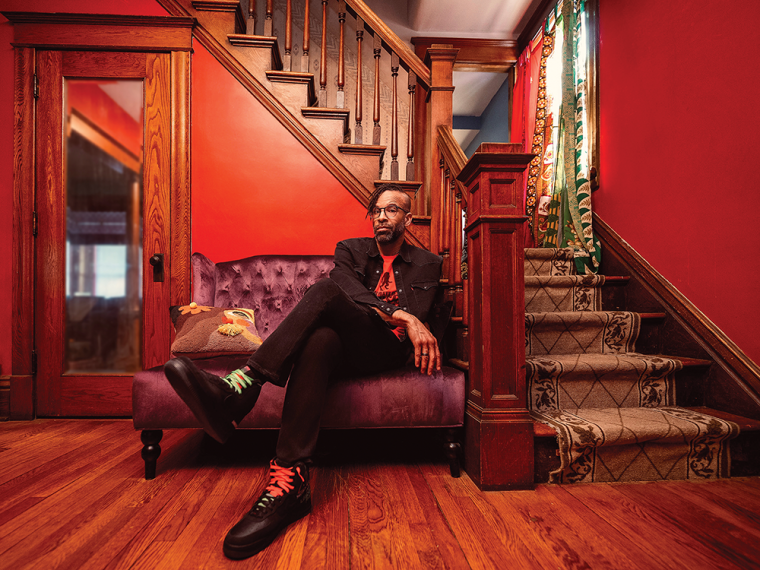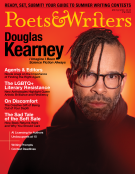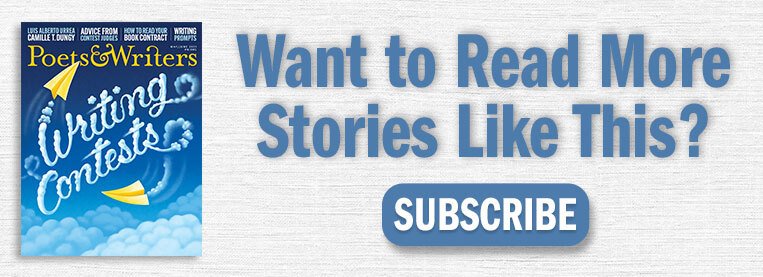It is less than forty-eight hours after Super Bowl LIX and the rapper Kendrick Lamar’s halftime performance (not to mention the Philadelphia Eagles’ blowout over the heavily favored Kansas City Chiefs) when I sit down for a Zoom interview with Douglas Kearney, an award-winning poet, performer, professor, and author of nine books, including the poetry collection I Imagine I Been Science Fiction Always, published by Wave Books in April. Kearney’s work is influenced by many musical genres, including hip-hop, jazz, and ragtime. As a librettist, he has garnered rave reviews for his staged operas, including Sweet Land, which was named 2021’s Best New Opera by the Music Critics Association of North America. Optic Subwoof (Wave Books, 2022), a collection of talks he presented for the Bagley Wright Lecture Series in 2020 and 2021, won the Poetry Foundation’s 2023 Pegasus Award for Poetry Criticism and CLMP’s 2023 Firecracker Award for creative nonfiction. Our midafternoon conversation was peppered with references to J Dilla and Herbie Hancock, and Kearney even sang a few bars of a popular hymn as he talked about his days as a Lutheran choir boy in Pasadena, California. (He grew up in nearby Altadena.) In the middle of so much talk about music, I couldn’t help but ask Kearney what he thought of the halftime show. Lamar’s performance, which broke Michael Jackson’s 1993 record for the most-watched halftime show in Super Bowl history, was a celebration of the Pulitzer Prize–winning rapper’s eclectic career, a love letter to his native Compton, and a cultural smorgasbord filled with coded criticisms of American democracy and direct shots at the Canadian rapper Drake, whom Lamar eviscerated in his five-time Grammy Award–winning diss track, “Not Like Us.”

Douglas Kearney, author of I Imagine I Been Science Fiction Always. (Credit: Krizia Studios)
Together Kearney and I joked about the flurry of social media’s armchair criticism, kicked up by Lamar’s use of backup dancers to form the shape of the American flag. At one point during the performance, the flag disperses as dancers fall to the ground, arranging themselves to look like individual swastikas. In the past two decades, both symbols have become calling cards for America’s far right, and Black artists like Sexyy Red and Beyoncé have been criticized for incorporating flag imagery in their work. However, as Kearney points out, Lamar’s signifying—the clever use of indirect language and imagery to convey complex ideas—is one of the hallmarks of Black art and is integral to understanding both Lamar’s performance and Kearney’s own poetry.
“You know, there are certain leadership figures in Black culture who look at the need to signify as an indication of weakness,” he says over Zoom from his office on the campus of the University of Minnesota Twin Cities, where he teaches creative writing. “But we need everything in the trick bag we can get. Yes, thank you for reminding us that there are moments where you’ve got to be like: ‘This is what I think. This is what I feel. This is who you are.’ I appreciate that. But there is something valuable in knowing how to do many different kinds of things, and in the making of my poetry, that’s what I’m playing with. I’m playing with multiple meanings at the same time. I’m [also] playing with statements that seem much less ambiguous—and working against those sorts of things. That has been a really big part of my work, although anybody who’s read [it] would probably agree that I have a very particular spot in my heart for the trickster,” he says with a chuckle.
Having read I Imagine I Been Science Fiction Always, I have to agree. Visually it is an astounding volume, opening with the book’s title spanning several pages in gigantic print, with the words Been and Science bifurcated by two black pages, one of them featuring the author’s name. In the following pages, Kearney’s gift as a visual poet is on full display in a series of six poem sequences. In each piece, he transforms images, texts, and the disruptions thereof into conversations about Black identity, personhood, and one’s inescapable relationship to the archive. The effect can at times be a dizzying one, but don’t be fooled: There is a precise method to the madness, or rather the genius, of Kearney’s work. His previous poetry collection, Sho (Wave Books, 2021), garnered several awards, including the Griffin Poetry Prize and the Minnesota Book Award. It was also a finalist for a National Book Award, a PEN/Voelcker Award, and the Kingsley Tufts Award.
“Hey, Sho did really well,” Kearney admits with a humble shrug. “People seemed to like it. [But] most critics who talked about it would note that ‘there isn’t the graphic design stuff in this one.’ One of the reasons I’m excited about this [new] book is that…there is this part of me that’s imagining somebody who liked Sho will open it and be like, ‘What? What is happening right now?’ That [anticipation] actually became a part of the sequencing of the book, this way of referencing the encroachment, the invasion of science fiction.”
As Kearney explains, the relatively traditional arrangement of the titular poem, which also appears first in the collection, is highly intentional. The poem’s small block text explodes into larger text over the course of a dozen or so pages, and near the poem’s end only the letter I remains, like a seeming glitch of the machine, or typeset run amok. In the following sequences, image overtakes standard text altogether. The second poem, “Shuttleblack Gettin Up Epic,” begins with archival sketches of fugitive enslaved people, then slips into comics, diagrams, and brand logos (like the one for Converse All Star sneakers, a shoe that was ubiquitous in early hip-hop culture). By the third sequence, “Over Deluxe AF,” there are mathematical equations, multiple-choice questions, and Kearney’s own use of American flag imagery. In his case, the flag often appears only in fragments—and is first displayed upside down.
Particularly moving is the opening sentence of “Over Deluxe AF,” which appears alone on a single page. It is a statement both familiar and profound. The phrase “What had happened was” is well known in African American culture; speakers often use it at the beginning of a humorous tale or at the start of a meandering (and sometimes self-serving) explanation of mischief. Here, however, Kearney places a period at the end of the statement, writing it as: “What had happened was.” As such, it operates as both the beginning of the sequence and as a declarative assessment of a racialized past. This strikes me as emblematic of Kearney’s work, and when I ask him about it, he beams.
“One of the things that informs the way I think about language is the usage of sampling in music,” he says. “On the one hand, you sample this line, and it’s this plastic object. Now you have a sample, which might be four words. What I find really interesting is how you can take the same phrase, or a clause, or a sentence, and by creating space in it, it changes the meaning. Out of this one unit, you can compose entirely new meanings.”
To this end, Kearney insists that the “objects” at a poet’s disposal must be chosen intentionally, because their relationship to our visual, digital, and linguistic archives is—and always should remain—important. As he explains his process for writing the book, Kearney makes clear that every word and image carries layers of meaning, which serves as a warning for readers who are too quick to appreciate only the visual novelty of his work and to fellow artists who utilize the archive without discernment.
“Erasure poems have had a real popularity over the last twenty-five years, and it’s a cool way to compose something,” says Kearney. “But for me, if the text you’re erasing doesn’t have any particular connection to what you’re saying, you just needed a dictionary, a lexicon. The tension to me comes from saying: These words are in this thing, and if you change this thing, you see this here. This is the hidden context; this is the subversion of this thing. I’m always looking for the relationship when things are juxtaposed, and that became a really important component of [the fourth sequence in the book] the ‘Dark Matter Armory Flex’ series. I figured, ‘Oh, I should use party flyers’—before that I hadn’t given myself permission to use certain kinds of images and textual objects. But once I was like, ‘Oh, I can do that,’ suddenly I have something somebody’s going to remember, or at least remember seeing something similar. That is collaborating with the archive.”









